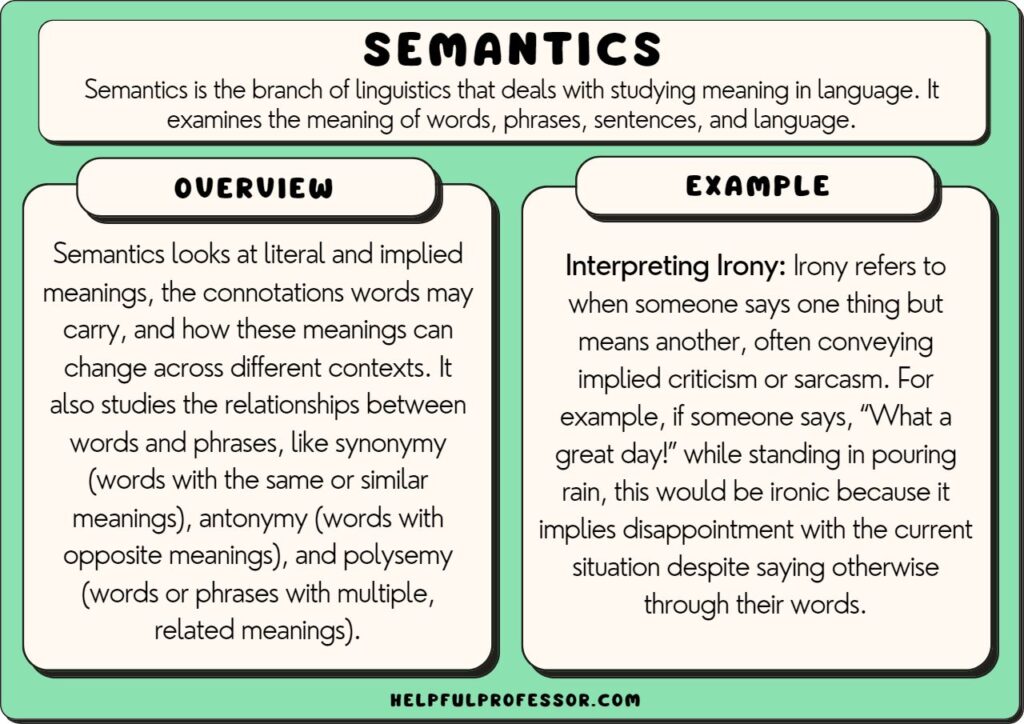

Written by Viktoriya Sus (MA)

Viktoriya Sus is an academic writer specializing mainly in economics and business from Ukraine. She holds a Master’s degree in International Business from Lviv National University and has more than 6 years of experience writing for different clients. Viktoriya is passionate about researching the latest trends in economics and business. However, she also loves to explore different topics such as psychology, philosophy, and more.
| June 13, 2023 Reviewed by Chris DrewDr. Chris Drew is the founder of the Helpful Professor. He holds a PhD in education and has published over 20 articles in scholarly journals. He is the former editor of the Journal of Learning Development in Higher Education.


Semantics is the branch of linguistics that deals with studying meaning in language. It examines the meaning of words, phrases, sentences, and language.
Semantics concerns how meaning is constructed and conveyed through signs, words, phrases, or sentences.
It acknowledges that word choice matters, and so too does context. If I were to say “Oh lord, have mercy!” it might mean something entirely different if I’m in Church versus saying it as part of a comedy skit. In one context, it might be very serious, and in another, very lighthearted. But, it’s the exact same sentence.
Overall, semantics is concerned with understanding how language speakers produce meaning using linguistic structures and how listeners and readers understand and interpret that meaning within contexts.
Contents showComprehension Questions: As you read through this article, our editor Chris will pose comprehension and critical thinking questions to help you get the most out of this article. Teachers, if you assign this article for homework, have the students answer these questions at home, then use them as stimuli for in-class discussion.
In linguistics, semantics is defined as the study of meaning in language, including the study of meaning in individual words, phrases, sentences, and larger discourse units (Riemer, 2010).
It is concerned with examining the relationship between words and their meanings and how these meanings are constructed, understood, and communicated within particular contexts.
From a cognitive psychology perspective, semantics involves understanding how we create meaning from a language using mental processes.
This includes processes such as categorization, inference, and mental representation (Clark & Toribio, 2012).
For example, when we hear the word “dog,” our brain automatically categorizes it as an animal. Then, it connects this meaning to other dog-related concepts, such as barking, wagging tails, or being man’s best friend (we do this because we create cognitive schema, a key concept from Piaget’s cognitive development theory).
This automatic categorizing of a word can affect our interpretation of entire sentences, paragraphs, or conversations.
Research in semantics aims to identify the underlying mental processes that govern language meaning, such as perception, memory, and thought.
It can help us understand how we use language to communicate, how differing interpretations can arise, and how language can convey different meanings in different contexts.
Bagha (2011) believes that semantics:
“…is the most abstract level of linguistic analysis since we cannot see or observe meaning as we can observe and record sounds” (p. 1411).
By analyzing the meaning of individual words or phrases and their relationships within larger discourse units, linguists and cognitive scientists can better understand the cognitive mechanisms of human communication.
Simply, semantics is a branch of linguistics that studies how people understand language.
Comprehension Checkpoint: Based on the above overview, write your own paraphrased definition of semantics. Key words might include “language”, “meaning”, and “context”.
The following examples demonstrate how we can use semantics alongside pragmatics (reading words in context) to develop meaning of communication:
Comprehension Questions: As we have seen, a lot of the work of a scholar of semantics is to understand not just the literal meaning of a word, but also the implied meaning. Consider from your own dialect or language a turn of phrase that is non-literal (e.g “he’s a legend” or “that tennis player is the GOAT!”). Write down what the phrase would mean literally, and what its non-literal meaning is.
When studying the meaning of language, several different branches of semantics exist to consider. These include formal semantics, lexical semantics, and conceptual semantics.
Formal semantics is a branch of semantics that uses mathematical and logical tools to study the meaning of language (Maienborn et al., 2019).
It is concerned with developing precise, formal representations of the meaning of language to understand how sentences are truth-conditionally related.
Formal semantics focuses on the precise meaning of words and phrases within a context and how they combine to produce meaning.
Take, for example, the phrase “for every girl, there are two boys.” We can turn this into a logical formula using formal semantics, in the form “1y = 2x”, where y is girl and x is boy.
We see formal semantics as an underpinning concept in computer coding languages, like Microsoft’s Visual Basic language, where language is used as a way for coders to produce clear and logical text.
Lexical semantics is the branch of semantics that is concerned with the meanings of words and phrases.
It involves analyzing the different senses of words and how they relate to one another (Maienborn et al., 2019).
Lexical semantics is concerned with understanding how individual words and phrases contribute to the overall meaning of a sentence or discourse.
For example, the word “bank” has different senses depending on the context. In a financial context, “bank” refers to a financial institution. In contrast, “bank” refers to the water’s edge in a river context.
Lexical semantics can help us to identify the correct word use by contextualizing it in surrounding language and context. For example, a scholar of the bible might take ambiguous words in the bible and try to identify its most likely meaning by examining it in the context of the era in which it was written.
Conceptual semantics is a theoretical framework that explores the relationship between language and thought.
It proposes that language and thought are closely related and that our conceptual systems shape our linguistic systems.
Conceptual semantics looks at the underlying conceptual structures that give rise to language and how words and phrases are used to express these conceptual structures (Maienborn et al., 2019).
For example, the word “happiness” expresses a positive emotion linked to an underlying cognitive structure that includes joy, pleasure, and contentment.
Conceptual semantics can also be linked to the Sapir-Whorf hypothesis, where it is believed that language determines thought processes, and each language structure also shapes how people think about, conceptualize, and act in the world.
Comprehension Questions: In your notebook, write down the three different types of semantics listed above, and two bullet-points notes each to help you remember unique aspects of each type.
Semantics plays a crucial role in our everyday lives as we constantly use and interpret language to communicate meaning.
Here are some examples of how semantics is applied in everyday life:
A pun is a form of wordplay that takes advantage of the various semantic meanings of words to create humor.
“Why did the tomato turn red? Because it saw the salad dressing!” (Raskin, 2012).
Here, the word “dressing” has two semantic meanings: as a type of sauce and as the act of getting dressed. The pun is created when the second meaning is used to create a play on words.
Companies use semantics to create brand names, slogans, and advertising messages that convey a positive message and evoke certain emotions (Schutte, 1969).
For instance, a perfume ad that uses words like “sensual” and “luxurious” to describe the fragrance uses semantics to make the product more appealing to customers.
Comprehension Checkpoint: Research the slogans of five large companies, such as shoes, clothing, cars, or tech companies. Do any of these companies employ language forms that are non-literal or ambiguous? (An ambiguous example would be “just do it” from Nike. The question would be: just do what?) What do you think is the reason why companies use non-literal and ambiguous slogans?
Translating from one language to another requires careful consideration of semantics, as certain words may not have an exact translation in the target language.
Translators must analyze the semantic meaning of a word or phrase and find ways to convey that meaning in the target language (Maienborn et al., 2011).
Semantics are often used in everyday social interactions to convey meaning beyond the literal meaning of spoken words.
For example, if someone asks, “How are you?” the response may be, “I’m fine,” even if the person is not really feeling fine.
The conversation is guided by the semantic meaning of the words rather than their literal meaning. The terms are used as formalities, not as genuine questions expecting a genuine response.
Editor’s Note: When I was teaching in England, people would say “you alright?” as a way of asking “how are you?” Where I came from, “are you alright?” would only be asked if someone looked like they were hurt or in distress. So, I had to re-learn “you alright?” to mean, more literally, “hello” and not an expression of concern!
Semantics play an important role in legal interpretation, where the precise meaning of words and phrases can significantly impact legal outcomes.
Lawyers must understand the semantic meaning of the words used in contracts and legal documents to interpret and argue their various points (Skoczeń, 2016).
In fact, there is significant semantic debate within the United States between the “constitutional originalism” vs “living constitution” schools of thought:
For example, the term “men” in the constitution may once have mean only men and not women, whereas today, judges tend to interpret it as adults, since today, men and women are seen as equal participants in society.
Linguistics has a particular area called semantics which studies how meanings are conveyed through words and phrases in a given context.
It examines how different words, phrases, and concepts combine to create the complete meaning of a sentence or conversation.
Today, researchers identify three main types of semantics: formal, lexical, and conceptual. Each of these looks at language from a slightly different perspective and helps us understand how meaning is created through language.
Understanding semantics is important in our daily lives because it improves communication and enables us to grasp the implied meanings of words and phrases.
From puns to legal interpretation, semantics is a core part of human language that cannot be ignored.
Bagha, K. N. (2011). A short introduction to semantics. Journal of Language Teaching and Research, 2(6), 1411–1419. https://doi.org/10.4304/jltr.2.6.1411-1419
Clark, A., & Toribio, J. (2012). Language and meaning in cognitive science. London: Routledge.
Hussain, S., & Sajid, S. (2015). Semantics in EFL classroom: A brief review. Journal of Humanities and Social Science, 20(9), 39–43. https://doi.org/10.9790/0837-20933943
Maienborn, C., Heusinger, K., & Portner, P. (2019). Semantics – theories. Walter de Gruyter GmbH & Co KG.
Raskin, V. (2011). Semantic mechanisms of humor. New York: Springer.
Riemer, N. (2010). Introducing semantics. Cambridge: Cambridge University Press.